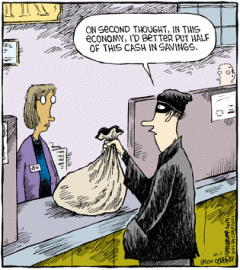From Lars Syll In modern times legal currencies are totally based on fiat. Currencies no longer have intrinsic value (as gold and silver). What gives them value is basically the legal status given to them by government and the simple fact that you have to pay your taxes with them. That also enables governments to run a kind of monopoly business where it never can run out of money. Hence spending becomes the prime mover and taxing and borrowing is degraded to following acts. If we have a depression, the solution, then, is not austerity. It is spending. Budget deficits are not the major problem, since fiat money means that governments can always make more of them. Financing quantitative easing, fiscal expansion, and other similar operations, is made possible by simply crediting a bank
Topics:
Lars Pålsson Syll considers the following as important: Uncategorized
This could be interesting, too:
tom writes The Ukraine war and Europe’s deepening march of folly
Stavros Mavroudeas writes CfP of Marxist Macroeconomic Modelling workgroup – 18th WAPE Forum, Istanbul August 6-8, 2025
Lars Pålsson Syll writes The pretence-of-knowledge syndrome
Dean Baker writes Crypto and Donald Trump’s strategic baseball card reserve
from Lars Syll
In modern times legal currencies are totally based on fiat. Currencies no longer have intrinsic value (as gold and silver). What gives them value is basically the legal status given to them by government and the simple fact that you have to pay your taxes with them. That also enables governments to run a kind of monopoly business where it never can run out of money. Hence spending becomes the prime mover and taxing and borrowing is degraded to following acts. If we have a depression, the solution, then, is not austerity. It is spending. Budget deficits are not the major problem, since fiat money means that governments can always make more of them.
Financing quantitative easing, fiscal expansion, and other similar operations, is made possible by simply crediting a bank account and thereby – by a single keystroke – actually creating money. One of the most important reasons why so many countries are still stuck in depression-like economic quagmires is that people in general – including most mainstream economists – simply don’t understand the workings of modern monetary systems. The result is totally and utterly wrong-headed austerity policies, emanating out of a groundless fear of creating inflation via central banks printing money, in a situation where we rather should fear deflation and inadequate effective demand.
The mainstream neoclassical textbook concept of money multiplier assumes that banks automatically expand the credit money supply to a multiple of their aggregate reserves. If the required currency-deposit reserve ratio is 5%, the money supply should be about twenty times larger than the aggregate reserves of banks. In this way the money multiplier concept assumes that the central bank controls the money supply by setting the required reserve ratio.
In his Macroeconomics – just to take an example – Greg Mankiw writes:
We can now see that the money supply is proportional to the monetary base. The factor of proportionality … is called the money multiplier … Each dollar of the monetary base produces m dollars of money. Because the monetary base has a multiplied effect on the money supply, the monetary base is called high-powered money.
 The money multiplier concept is – as can be seen from the quote above – nothing but one big fallacy. This is not the way credit is created in a monetary economy. It’s nothing but a monetary myth that the monetary base can play such a decisive role in a modern credit-run economy with fiat money.
The money multiplier concept is – as can be seen from the quote above – nothing but one big fallacy. This is not the way credit is created in a monetary economy. It’s nothing but a monetary myth that the monetary base can play such a decisive role in a modern credit-run economy with fiat money.
In the real world banks first extend credits and then look for reserves. So the money multiplier basically also gets the causation wrong. At a deep fundamental level the supply of money is endogenous.
One may rightly wonder why on earth this pet mainstream neoclassical fairy tale is still in the textbooks and taught to economics undergraduates. Giving the impression that banks exist simply to passively transfer savings into investment, it is such a gross misrepresentation of what goes on in the real world, that there is only one place for it — and that is in the …
